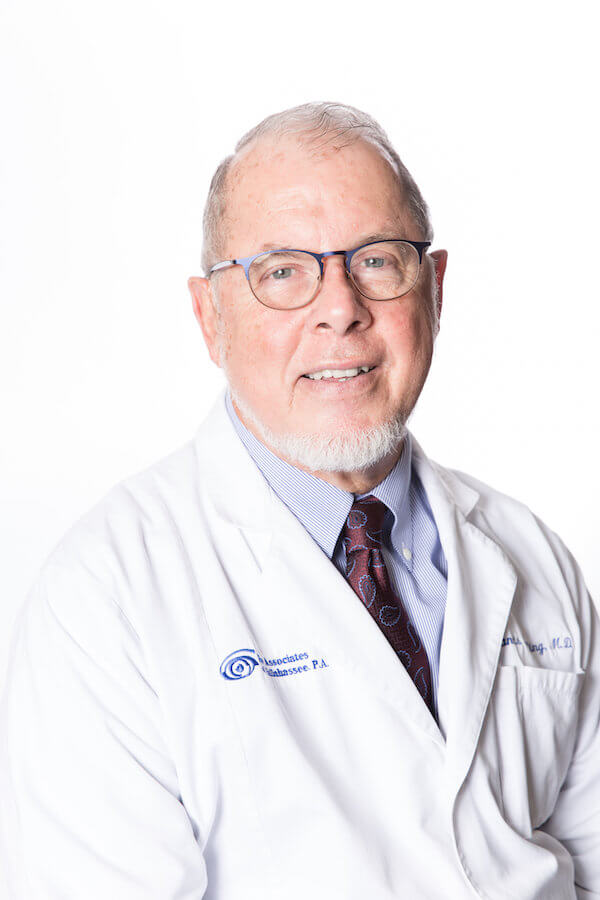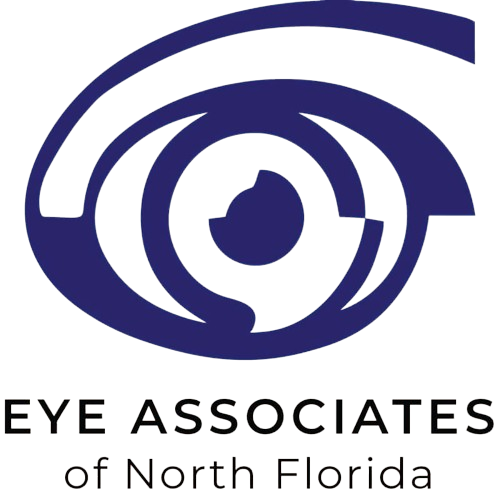To be Frank…


Dr. Skilling retires after forty-five years in ophthalmology
There aren’t enough words to describe Dr. Francis Skilling’s forty-five-year tenure in the medical field. After forty-two years at Eye Associates of Tallahassee and serving thousands of patients, Dr. Skilling’s retirement is bittersweet to many. He has been a leader in the North Florida medical community, and we will miss his friendly personality in our office. As he wraps up his career, we had a chance to sit down with Dr. Skilling to reflect on a few highlights over the years.
Why did you decide to go into ophthalmology?
I have always wanted to be a doctor, at least that’s what my mother told me. I was influenced by my father, an ophthalmologist in Miami, and my mother, a registered nurse. However, I knew nothing about ophthalmology or any other medical field except that doctors were supposed to help people.
I started at the University of Alabama School of Medicine in the fall of 1968, and I liked everything in the medical field, but I gradually eliminated some areas: obstetrics had an unpredictable schedule; treating children in general pediatrics didn’t thrill me; the schedule for general surgery was brutal. I liked internal medicine immediately. However, once I took an externship at the Bascom Palmer Eye Institute at the University of Miami, I was enchanted with ophthalmology. I especially liked the neuro-ophthalmology service because it encompassed the connections between the eye and the brain.
After spending two years as a Navy medical officer, I decided to try for an ophthalmology residency, since they were among the most competitive. I reasoned that if I didn’t like the field after one year I could switch to an internal medicine residency. Six months at the University of Texas Medical Branch in Galveston confirmed my love of the field. I have never regretted being an ophthalmologist for a single day. It requires surgical skill, diagnostic acumen, familiarity with other medical fields, and has great “toys” to work with. During my residency, I discovered that I liked working with children and their eye problems, so pediatric ophthalmology remained a constant interest throughout my career, although I enjoyed most other aspects too.
How has ophthalmology changed over your tenure?
There have been so many advances in ophthalmology in the forty-five years I’ve been in the field that it’s hard to enumerate them. Eye surgery has become almost completely outpatient. My first cataract surgery patients in Texas routinely spent five to seven days in the hospital. Intraocular lenses implanted at the time cataracts were removed were controversial when I was in training, but after the early 1980s, they became routine, as did small incision surgery. Laser surgery for retinal diseases, including diabetic retinopathy and macular degeneration, has saved the vision of countless patients. Glaucoma surgery has become safe and predictable. Laser vision correction is now a routine outpatient procedure. Eye medications, especially glaucoma drops, have advanced to an almost unbelievable level. Most of the medicines that we routinely used in the 1970s had significant side effects, especially for elderly patients. In Tallahassee I was the first ophthalmologist to do an outpatient eye muscle surgery on a child in 1983 at Tallahassee Single Day Surgery. After the success of the first case, I stopped doing pediatric inpatient procedures. Another significant change has been the introduction of electronic health records. When I joined Lee Elgin our paper charts were folded sheets of white paper. Now everything is digitized and stored electronically.
“I have never regretted being an ophthalmologist for a single day.”
Why did you come to Tallahassee?
In a few words, it was because I was invited by Lee Elgin, Jr., M.D. He had been in practice here since 1960, and he was looking for a partner. Our families had known each other in Miami, and I had decided that I wasn’t going back to South Florida to live. By this time, I had married Karen, whom I had met while I was doing my residency in Texas. We wanted to move back east to be closer to our parents, and Tallahassee seemed like an ideal location. We both wanted our children to grow up in a more diverse atmosphere that Tallahassee seemed to offer. We have never been unhappy with our choice. All our children were born here and graduated from Leon High School, although they all live in different cities now.
When I joined Lee Elgin, we practiced in a small office in the Medical Arts Building across from TMH. A Walgreens store now occupies that corner. Baxter Byerly, M.D. joined us in 1981, and we built a new building on Capital Medical Boulevard across from what is now CRMC. Tony Weaver M.D. joined us in 1990. He was the first to utilize phacoemulsification and small incision surgery. Ken Kato, M.D. followed in 1993 after completing his residency at the University of Florida. Jerry Ford M.D., with a sub-specialty in corneal transplants, came in 2000. By then we realized that we needed more space for doctors, patients, and staff. We designed and built our current office, and we moved in during a tropical storm in August 2004. Viet Bui, M.D. joined us in 2009 after fellowships in corneal and glaucoma surgery. In 2015 we had the addition of Sarah Ko, M.D.; fortunately for us, Sarah had been raised here and wanted to return to her hometown after completing her residency at the Wilmer Institute and a fellowship in glaucoma in London. Deanna Louie, M.D. joined the group in 2016 and brought a breadth of experience as a surgeon.
Tell me about a significant time that you felt like you helped a patient.
It’s hard to recall just one outstanding patient. Because I took care of so many children, I got to know their families as well, and even forty years later, I occasionally run into someone whose child I took care of. One man I saw in Quincy early this year reminded me that I’d operated on his son for a serious eye injury in 1981. His recovery and post-operative vision therapy were long, and I remember how attentive his mother was in keeping a contact lens on a toddler. My interest in neuro-ophthalmology enabled me to see many patients who had brain tumors that threatened their vision, and I like to follow up with them as the years go by. In my early years of practice when I wasn’t quite so busy, I’d have 4:30 PM appointments for especially interesting patients just so we could talk after the office closed at 5:00 PM. One I well remember was an FSU nutrition professor who’d had polio as a child and still wore leg braces and used crutches. Her disability never slowed her down, and she wrote one of the most popular textbooks on clinical nutrition. We had long talks on every field imaginable. She was the first person I knew who wrote an entire manuscript for a textbook on a revolutionary new device called a “word processor” at a time when personal computers were rare.
What type of legacy do you hope to leave on our office, our patients, and our community?
My fervid hope is that Eye Associates of Tallahassee will continue to thrive and provide the top-quality eye care that our patients and staff have come to expect. Almost every patient I’ve talked to has had a positive experience in our practice. We have come to be known as the premier eye care provider in North Florida and South Georgia. 2020 marks the 60th year of the founding of the practice in Tallahassee, and I hope that we will be able to continue to provide quality eye care and surgery for our patients into the far distant future.







